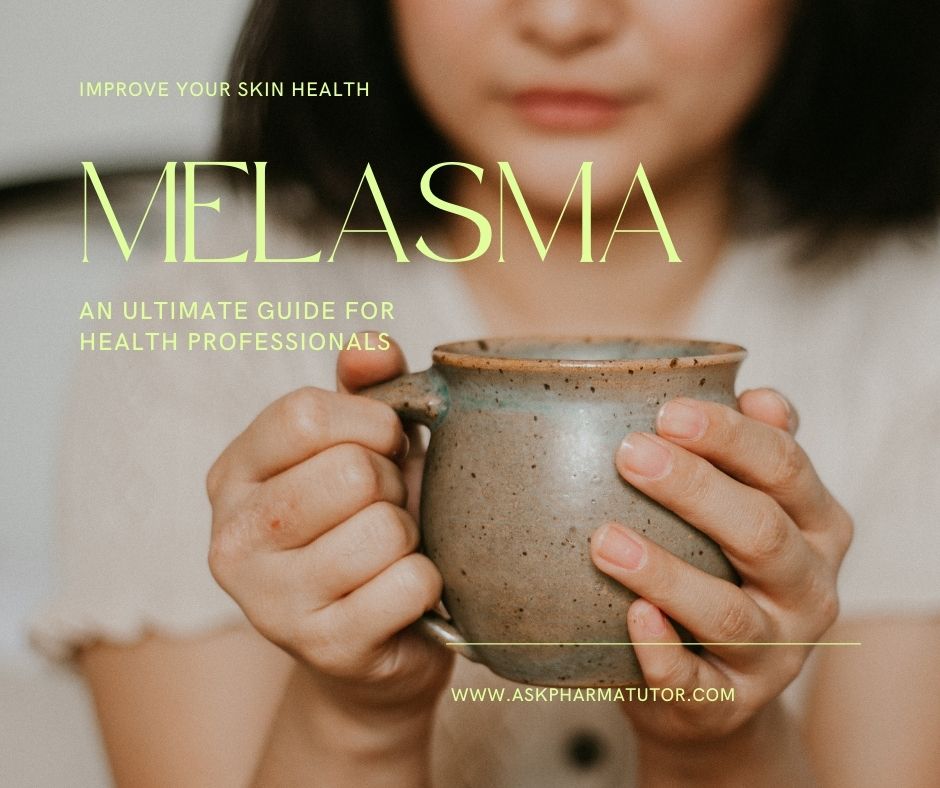Melasma, also called ‘chloasma’ and ‘pregnancy mask’, is a common skin condition of adults in which brown or greyish patches of pigmentation (colour) develop, usually on the face. The name comes from melas, the Greek word for black, or cholas, from the word green-ish. It is more common in women,
particularly during pregnancy (when up to 50% of women may be affected). Sometimes men may also be affected. Melasma is more common in people of colour and those who tan very quickly but can occur to anyone.
Melasma usually becomes more noticeable in the summer and improves during the winter months. It is not an infection; therefore, it is not contagious, and it is not due to an allergy. It is not cancerous and will not develop into skin cancer.
For more information about Acne click HERE.
In this guide you will learn basics and current clinical treatment for melasma.
What are the symptoms of Melasma?
What are the current treatment strategies for Melasma?
Melasma Causes
The exact cause is not known, but it is thought to be because of pigmentproducing cells in the skin (melanocytes) producing too much pigment (melanin). Several factors can contribute to developing melasma, including pregnancy and using hormonal drugs such as birth control pills and hormone
replacement. Rarely, other medical problems that affect hormones (such as thyroid problems) may cause melasma, as well as some other medications, such as anti-epileptics.
Exposure to ultraviolet (UV) light from the sun and the use of sun-beds or phototherapy can trigger melasma or make it worse.
How Melasma Looks
Melasma appears darker than the surrounding skin- affecting the cheeks, forehead, upper lip, nose and chin. It can also affect other areas of the body exposed to the sun, such as the forearms and neck. Areas of melasma are flat, not raised.
Symptoms of Melasma
Most patients are upset by the appearance of melasma, but it has no physical symptoms. Affected skin is not itchy or painful.
Melasma appears in six locations or a combination of locations on your skin:
- Brachial: The melasma appears on your shoulders and upper arms.
- Centrofacial: The melasma appears on your forehead, cheeks, nose and upper lip.
- Lateral cheek pattern: The melasma appears on both cheeks.
- Malar: The melasma appears on your cheeks and nose.
- Mandibular: The melasma appears on the jawline.
- Neck: In people age 50 or older, melasma can appear on all sides of the neck.
Your healthcare provider will decide for sure if you have melasma or another type of skin disorder.
Diagnosis
Melasma can sometimes be mistaken for another skin condition. To tell the difference between skin conditions, your healthcare provider may perform a biopsy, which is where a small piece of your skin is removed and examined. A biopsy is quick, safe procedure routinely performed during a normal visit to your healthcare provider’s office. Skin conditions commonly confused with melasma include:
- Actinic lichen planus and lichen planus.
- Drug-induced pigmentation.
- Guttate hypomelanosis.
- Hydroquinone-induced exogenous ochronosis.
- Lentigo (age spots).
- Nevus of Hori.
- Nevus of Ota.
- Postinflammatory pigmentation.
If you have melasma, the results of the biopsy will typically reveal the following:
- Dendritic (branched) pigmented melanocytes.
- Melanin in the basal and suprabasal keratinocytes.
- Melanin in the dermis within melanophages.
- Solar elastosis and elastic fiber fragmentation.
The severity of your melasma can be measured by using the Melasma Area and Severity Index (MASI). Your healthcare provider may administer the test.
Can Melasma Be Cured?
No, at present there is no cure for melasma, but there are several treatment options that may improve the appearance. If melasma occurs during pregnancy, it may go away a few months after delivery and treatment may not be necessary- though it may come back during another pregnancy.
Hydroquinone and retinoid creams should be avoided in pregnancy as they could harm the foetus. Even if it is treated, melasma often returns after stopping the treatments.
Current Treatment Strategies
Melasma treatments fall into the following categories and can be used together:
Avoiding known triggers, such as birth control pills and hormone therapy.
• Avoiding the sun and using sun-blocking creams.
• Lightening creams for Skin.
• Procedures such as chemical peels, microneedling and laser therapy.
• Camouflage of Skin.
Sun protection
Skin affected by melasma darkens more than the surrounding skin when exposed to light, so sun-avoidance and sun-protection are important (see the‘top sun safety tips’ below for more information).
One of the most important things you can do to prevent melasma worsening is protecting yourself from UV radiation. This means avoiding the sun, wearing a wide-brimmed hat when you are outside and wearing broad-spectrum sun cream (SPF 30 or above, with a high UVA rating). The higher the SPF the
more effective it will be.
Avoid using sun-tanning beds. Protecting your skin from the sun will also help the below treatments be more effective.
Skin lightening creams
Hydroquinone is a medicine that prevents pigment cells in the skin from producing melanin and is commonly used to treat melasma. It may cause skin irritation, and they should only be used for a few weeks at a time to prevent over-lightening of the skin. Hydroquinone can only be prescribed by doctors and may occasionally cause the skin to become darker.
Retinoid creams, usually used to treat acne, and some types of acid cream (such as azelaic acid, ascorbic acid and kojic acid) can help improve the appearance of melasma but can also cause skin irritation. Steroid creams can also be useful and are often mixed with the above chemicals to help prevent
skin irritation.
Some skin-lightening creams contain a combination of two or three ingredients to make them more effective. Skin lightening creams must only be used when prescribed, and under medical supervision to reduce the risk of side effects.
| Drugs | Drugs |
| Phenolic Compounds Non-phenolic Compounds Combination Formulas Hydroquinone Azeleic acid Kligman’s formula 4-isopropylcatechol Retinoids Modified Kligman’s formula 4-hidroxianisol L-ascorbic acid Triple cream Kojic acid Thiocytic acid N-acetyl-glucosamine N-acetylcysteine 4-methoxyphenol Licorice N-acetyl-4-S-cysteminylphenol | Corticosteroids 4-n-butylresorcinol Niacinamide Arbutine |
Procedures
Chemical peels can improve melasma by removing the outermost cells of the skin that contain the pigment. Chemical peels should be undertaken by an experienced practitioner as they could make the pigmentation worse, lighten the skin too much or cause scarring.
Microneedling is a process where the skin is repeatedly punctured with tiny needles to help creams penetrate deeper into the skin. This may result in pain, swelling, infections and scarring (including keloids).
Some types of laser also remove the outer layer of skin, whereas others target the pigment-producing cells (melanocytes). The success of laser therapy is variable, and there may be risks associated with this treatment, similar to those above. This procedure should only be performed by a highly
experienced laser operator.
Chemical peels, microneedling and laser are usually not available as NHS procedures. You should only seek these procedures from reputable and qualified providers – your NHS doctor should be able to advise on this.
Skin camouflage
It can be used to hide the pigmentation of melasma and has been shown to help improve quality of life. Skin camouflage is a thick, coloured crème, which is matched to your skin colour and is relatively difficult to remove. A health care professional will be able to help you locate a local
service.
New Treatment
Recently, scientists have found that tranexamic acid (a drug usually used to stop bleeding) is effective in improving the appearance of melasma in some patients.
Self care (What can I do?)
The most important thing you can do is to protect your skin from sunlight exposure and avoid the using sunbeds. If melasma improves, this effect can be maintained by protecting your skin
from the sun.
Top sun safety tips
Protect your skin with adequate clothing, wear a hat that protects your face, neck and ears, and a pair of UV protective sunglasses. Choose sun protective clothing (with permanently sun-protective fabric, widely
available for adults and children) if you have fair skin or many moles.
• Spend time in the shade between 11am and 3pm when it’s sunny. Step out of the sun before your skin has a chance to redden or burn.
• When choosing a sunscreen look for a high protection SPF (current recommendations are SPR 50 or 50+) to protect against UVB, and the UVA circle logo and/or 4 or 5 UVA stars to protect against UVA. Apply plenty of sunscreen 15 to 30 minutes before going out in the sun, and reapply every two hours and straight after swimming and towel-drying.
• Keep babies and young children out of direct sunlight.
• The British Association of Dermatologists recommends that you tell your doctor about any changes to a mole or patch of skin. If your GP is concerned about your skin you are advised to see a Consultant
Dermatologist – an expert in diagnosing skin cancer. Your doctor can refer you for free through the NHS.
• Sunscreens are not an alternative to clothing and shade, rather they offer additional protection. No sunscreen will provide 100% protection.


